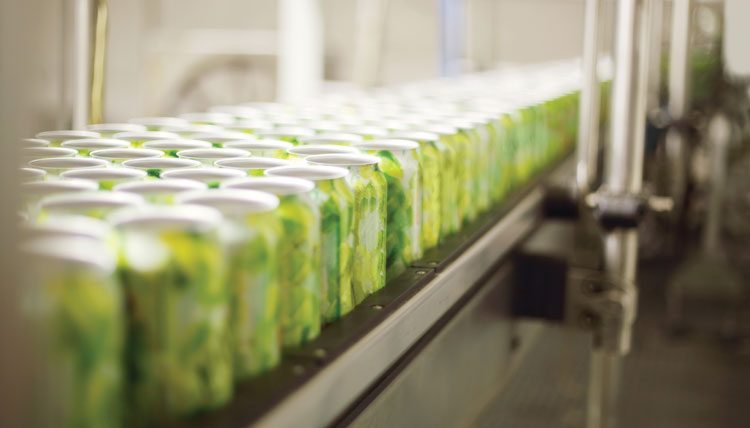Foreign body contamination and the implications for the food manufacturing sector
- Like
- Digg
- Del
- Tumblr
- VKontakte
- Buffer
- Love This
- Odnoklassniki
- Meneame
- Blogger
- Amazon
- Yahoo Mail
- Gmail
- AOL
- Newsvine
- HackerNews
- Evernote
- MySpace
- Mail.ru
- Viadeo
- Line
- Comments
- Yummly
- SMS
- Viber
- Telegram
- Subscribe
- Skype
- Facebook Messenger
- Kakao
- LiveJournal
- Yammer
- Edgar
- Fintel
- Mix
- Instapaper
- Copy Link
Posted: 1 May 2014 | Duncan Goodwin, Director of Technical Services, NSF Supply Chain Assurance Division | 2 comments
‘Foreign body’ is a technical term which refers to any extraneous matter, whether of a physical, chemical or biological nature, found in food. Usually foreign bodies render the food unfit for human consumption.


Strictly speaking, ‘physical contamination’ should refer to the addition of extraneous matter to food not directly of biological origin such as paper, paint or glass, but legally the term refers to all contamination of a non-microbial source, including human hair, parts of insects and cleaning fluids and also includes particles of the wrong food such as a butter bean found in a tin of peas. And remember, food includes beverages, bottled water and nutritional and functional products.
Much focus is placed on product labelling and process controls when addressing the problem of physical contamination. Many product recalls are in fact attributable to allergens and mislabelling or packaging. For example, the 2012 figures from the UK Food Standards Agency1 show that of the 100 plus alerts and food information notices, only 16 were associated with physical contamination with 14 Recall Information Notices (RIN) and two Withdrawal Information Notices (WIN) issued.
Looking at physical contamination incidents by category in 2012 compared to the previous year, they increased (107 reported cases against 93 cases in 2011), but in fact the average number of reports over the period 2006 – 2011 is 106 per year, so the reported incidents are not increasing overall, but neither are they declining. Physical contamination is therefore a perennial problem and one which we do not seem able to eliminate totally.
Table 1: Physical contamination incidents by sub-category 2012
|
Physical contamination sub-category |
No of incidents |
|
Metal |
34 |
|
Pests |
23 |
|
Plastic |
10 |
|
Glass |
10 |
|
Animal origin |
3 |
|
Wood |
3 |
|
Stone |
3 |
|
Rubber |
1 |
|
Other |
20 |
|
Total |
107 |
Source: Food Standards Agency Annual Report of Incidents 2012, Table 11, Page 37.
Table 1 indicates the breakdown of the 107 physical contamination incidents in 2012. Metal, plastic and glass account for half of the incidents. It is not possible to exclude these materials from manufacturing processes, both because equipment is made of metal and plastic and also packaging materials.
At a European level, the RASFF (Rapid Alert System for Food and Feed) notices highlight cross-border incidents where products are stopped, but in fact few of these are related to physical contamination issues.
It seems that food manufacturers may often be erroneously blamed for foreign body contaminations. A study by Glass Technology Services in the UK 2013 found that 70 per cent of fragments reported by consumers and submitted for analysis originated from items that are commonly found in the home. Nevertheless, the potential negative impact of publicity surrounding an incident means that manufacturers have to be meticulous, and their systems need to provide confidence that such complaints cannot have originated in their factories. If there is any doubt at all then this can lead to costly and damaging product recalls, with the attendant loss of direct revenue, costs of crisis management, communications costs and damage to brand reputation. For smaller companies, this can in the worst instances send them to the wall.
NSF’s own complaint handling service shows that 60 per cent of complaints reported by management across a range of UK and European clients in the food service and catering sectors, at ‘outlet’ level, are related to foreign bodies. Of those complaints that were justified2 in 2014, over 40 per cent were the fault of the manufacturer. Table 2 provides an overview of the key complaint categories and a breakdown of foreign body contamination.
Table 2: Justified complaints investigated by NSF in 2013
|
Complaint type |
Number of complaints |
|
Plastic |
362 |
|
Insect |
340 |
|
Other |
214 |
|
Bone |
196 |
|
Stone |
104 |
|
Hair |
97 |
|
Wood |
85 |
|
Metal |
57 |
|
Shell |
50 |
|
Glass |
20 |
|
Rubber |
17 |
|
String |
16 |
|
Crockery |
7 |
|
Extraneous Vegetable Matter (EVM) |
5 |
|
Meat in non-meat meal |
5 |
|
Sticking Plaster |
2 |
|
Parasite |
2 |
|
Grand Total |
1579 |
The NSF received a total of 3,807 foreign body complaints in this period. The ‘non-justified’ complaints were attributable either to introduction during handling at the outlet or cannot be attributed to either the supplier or the outlet. Some of these will be associated with the ingredients used in the product, for example parasites in fish or bone in chicken meat. Others are linked to production equipment and occur through maintenance practices, accidental loss or other introduction during production.
When we look at the wider complaints raised by clients, categories such as allergenic response, alleged food poisoning and product quality contribute approximately 3,000 justified reports. So, we see that a significant amount of time and effort is required to investigate and address underlying issues associated with the main foreign body complaints: plastic, hair, metal, wood, glass and rubber.
Of course, identification and sourcing of the offending item is just the first step. Prevention and elimination of foreign bodies requires a complex and multi-faceted approach which relies as much on human behaviours – processes, training and attitudes towards individual responsibilities – as it does on sophisticated (and sometimes still relatively unsophisticated) technological and mechanical screening and detection.
Why do we worry about foreign body contamination?
We have three key concerns as to why foreign body contamination is an issue and these are legislation, injury and brand protection.
1. Legislation
UK legislation, commencing with the Food Safety Act 1990 and continuing through the General Food Regulations 2004, introduced and maintain the concept of ‘due diligence’ which allows a manufacturer or seller to claim that, whilst the foreign body is present in the product, they have done as much as is ‘reasonably practicable’ to prevent the contamination.
European legislation3 requires that food complies with various hygiene regulations specifying that food must be safe. All potential hazards must be eliminated or reduced to an acceptable level.
In the US, the Food and Drug Administration (FDA) Regulations4 on Adulteration involving Hard or Sharp Foreign Objects legislates in this area. The FDA considers that a product is adulterated if it contains a sharp or hard foreign object that measures 7 – 25 mm in length, is ready to eat or requires minimal preparation that would not eliminate or neutralise the hazard prior to consumption. Failure to protect product may lead to prosecution by the regulatory authorities.
2. Injury
Injury can be the direct consequence of consuming product containing foreign materials, particularly where that product is coated, for example breaded chicken, or a thick drink, for example a smoothie, or a product consumed directly from the packaging, for example a tinned drink. As in many areas of life, consumers now believe that someone is at fault if they suffer harm, or even the potential of harm, so a ‘zero tolerance’ to complaints is now the norm.
3. Brand protection
Unlike food poisoning outbreaks, where often dozens, hundreds or thousands of people are affected, many foreign body incidents affect a single person, but these can still make the front pages, for example ‘Tesco Frog in Salad’ and ‘Mouse in Loaf of Bread’5.
This exposes the brand owner to adverse publicity and the threat of loss of brand reputation, loss of sales and potential closure, as mentioned previously. Manufacturers now look to brand protection as keenly as they do to food safety and legislative compliance. Consumer perception can be as powerful as reality.
What remedies can be used to prevent or reduce foreign material contamination?
While naturally occurring foreign bodies are unpleasant and can cause upset and injury to consumers, many of these can be screened using appropriate technical solutions such as x-ray detection, metal detection to identify bone fragments, glass or metals; or using processing techniques such as filtration and sieving to prevent foreign materials entering finished products (Table 3).
Table 3: Various elimination and detection methods to detect foreign bodies in food
|
Filtering |
Sieving |
Physical inspection |
Magnets |
|
Packaging rinsing |
Metal Detection |
X-ray scanning |
|
|
Materials Analysis |
DNA |
Radio-isotope identification |
Glass identification |
|
Phosphatase testing |
Scanning Electron Microscopy |
Stereo and light microscopy |
Chemical Spot Tests |
|
Fourier Transformed-Infrared Spectroscopy (FI-TR) |
Differential Scanning Calorimetry (DSC) |
Mass Spectrometry |
X-ray analysis |
However, when we look at foreign materials not associated with the ingredients or metals, these become more difficult to detect. Businesses therefore need to look carefully at their end-to-end product development, ingredient selection, screening and process controls to minimise the potential for materials to survive screening or be introduced during processing. Key is the inspection and maintenance of equipment and the pre-cleaning of packaging equipment prior to filling.
HACCP and GMP are well established process management techniques, and many companies have adopted third-party certification to verify their overall food safety management. But still complaints occur.
Control of materials in production environments is a major challenge and critical to the integrity of the finished products. HACCP and GMP plans are great, but key is how these are inspected on a day to day, month to month basis. Who checks that new ‘better’ equipment has not been introduced without going through a safety review? The new plastic scrappers introduced from a different supplier may not be to the same formulation and react differently when exposed to your process. Then you start to find pieces of plastic in product and it’s come from the new scrappers. If these had been trialled, you could have prevented the subsequent complaints.
So, it is no good for HACCP and GMP programmes to sit in isolation; they truly have to be companywide initiatives supported by working groups who maintain responsibility for process changes, value engineering propositions, and other activities which can affect product integrity.
Maintenance is often the cause of contamination through simple mistakes and failure to control activities, especially when emergency action is taken. Clear, return-to-work procedures need to be in place which are followed and inspected before production commences. Training engineers and maintenance teams is crucial to reduce the contamination associated with their activities.
Inspection of ingredient and packaging suppliers, detailed product performance specifications, testing and inspection programmes and use of certification, both of suppliers and individual batches of products all play a key role in increasing the quality of supplied products, and suppliers’ awareness about what is important. With increasing responsibilities on the manufacturers to recall / withdraw product in the event of a failure, getting these suppliers and quality assurance procedures right is critical.
Intake inspection sampling programmes will help improve the quality of ingredients, reducing the base load of contamination, but the sample sizes, screening methods, training of employees, action to isolate affected product, etc, all need to be understood to ensure effective inspection.
Also to be considered are the equipment design, and certification and design standards which exist to promote hygienic performance. For example, the standards and protocols from EHEDG6, 3-A7 and NSF International8. Adoption of these will mean that your equipment has been designed and constructed to reduce the potential for product contamination or failure.
Ultimately, people will normally do the right thing, providing they are given clear support when they report problems. But if the factory management ignores concerns, people stop caring and then failure can go unreported until complaints start to be received.
Looking at detailed complaint analysis and trends will also give alternative ideas and approaches to help understand and review your own processes to reduce the potential for contamination. For example: PAS 96:2010 Defending Food and Drink and ISO10393 Consumer Product Recall – Guidelines for Suppliers.
And above all else, make sure and have confidence that your own house is in order, so that those complaints which originate when the product is outside of your control can be refuted. We have not explored deliberate or malicious contamination in this article. This is a significant, and often, unreported area of concern and one which is an important topic deserving separate treatment.
Conclusion
Technologies exist to help identify problems with finished product, but prevention techniques will have greater impact on reducing potential failures. People will be the greatest asset in creating the environment to catch problems before the products are dispatched.
Brand protection is vital, but the problem is that the accepted best practice methods of achieving food safety – policies, standards, inspections, paper trails and training – are not reducing risks and doing more of them has little incremental effect on safety.
Increasingly, it is recognised that the biggest risk in any business is human behaviour. The argument is that paperwork and systems are to no avail if they are not followed or applied correctly and the evidence is that in many cases staff do not understand or misapply information that they have received. Many costly issues relate directly back to human behaviour, including food poisoning incidents, customer complaints, workplace injuries, compliance or regulatory fines. So staff behaviour is a constant business risk exposure and needs to be managed more effectively as part of the overall risk management mix in order to make measurable improvements in food safety.
References
- FSA reports: Incident Report 2012
- Justified: we use the term justified to identify where a complaint that is made by a client is found to be true, and the manufacturer or supplier has accepted that the foreign material originated whilst in their control/manufacture
- EU legislation: 178/2002: laying down the general principles and requirements of food law, establishing the European Food Safety Authority and procedures in matters of food safety 852/2004 (and associated regulations): on the hygiene of foodstuffs
- FDA Regulations on Adulteration Involving Hard or Sharp Foreign Objects: http://www.fda.gov/iceci/compliancemanuals/compliancepolicyguidancemanual/ucm074554.htm
- http://www.theguardian.com/lifeandstyle/wordofmouth/2012/sep/19/waiter-theres-a-frog-in-my-spinach
- Equipment Design Standards and Protocols: EHEDG, European Hygienic Engineering and Design Group: www.ehedg.org
- 3-A, 3 A Sanitary Standards Inc: www.3-a.org
- NSF: www.nsf.org/services/by-industry/food-safety-quality/food-equipment-certification
About the author


Duncan Goodwin, Director of Technical Services, NSF Supply Chain Assurance Division
Duncan Goodwin has worked for NSF (formerly CMI) for 15 years providing strategic and technical support to clients in matters relating to food safety, food hygiene, packaging, social responsibility and health and safety. He has worked extensively throughout Europe with food service, food manufacturers and food packaging companies. His background is in environmental health and more latterly supply chain technical services, both managing contract delivery and the in-sourcing of technologists and quality professionals. He has a BSc degree in Environmental Health and a Master’s degree in Food Law. He is a member of the Institute of Food Science and Technology and an Associate of the Institute of Quality Assurance.








I appreciated it when you shared that Much spotlight is set on item naming and interaction controls while tending to the issue of actual defilement. Numerous item reviews are indeed inferable from allergens and mislabeling or bundling.
I have found a foreign body in a pot of yogurt. It is small but sharp and jagged and if swallowed could cause severe damage internally. I refer to it as plastic but it could be glass and is white the same colour as the yogurt. What procedure should I adopt? I have notified the producer who have asked me to send the object to them.